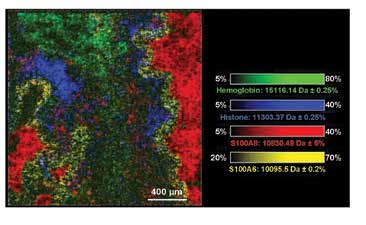MALDI Mass Spectrometry Imaging (MSI) allows for scientists to visualize the spatial distribution of peptides and proteins. Each experiment creates many images and allows for investigators to visualize multiple species at once. The MALDI source is especially well suited to proteomics because large molecules such as proteins and peptides are prone to damage by harsher ionization sources.
Matrix application is a critical step in MALDI mass spectrometry imaging of proteins and peptides due to the need to extract the analytes from tissue without sacrificing image resolution. The HTX MALDI matrix Sprayers are ideal sample preparation instruments for proteomics MALDI MSI work as they allow you to perform trypsin digestion and matrix application using one instrument.
HTX Application Note #38
Selected MALDI FTICR MS ion images of intact proteins from mouse kidney infected with S. aureus. MALDI FTICR IMS experiments are highly valuable for immunological biology given that post-translational modification of proteins (i.e. oxidation) play a key role in the immune response.
HTX Application Note #39
MALDI IMS of intact proteins is of great relevance for biomedical research, since it provides spatial information of endogenous proteins, as well as their post-translational modifications. However, intact protein imaging faces a number of inherent challenges related to throughput, the sensitivity at high spatial resolution, rates of image acquisition, and molecular specificity and identification. Next-generation platforms such as ultra-high speed MALDI-TOF and high mass resolution MALDI FTICR mass spectrometers can override such limitations, improving protein acquisition rates by ten-fold, achieving 10 µm spatial resolution with high sensitivity, and resolving protein isotopes up to ~20 KDa.



